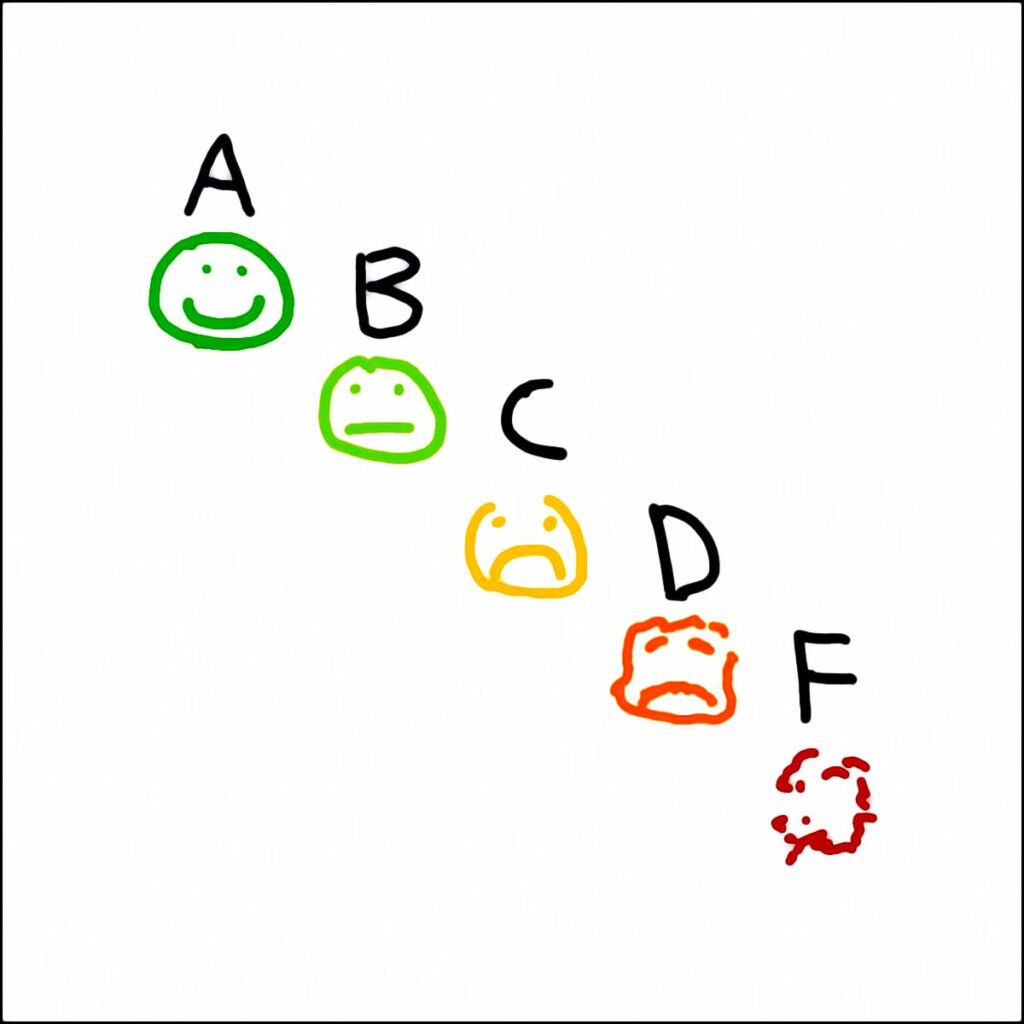Authentic Feedback
Classroom Management Part I
Thinking back on my school years, I remember sitting in classrooms. Classrooms controlled by adults who tried to regulate my every decision of my every day.
I clearly see a teacher standing at the front of the classroom with students lined up in neat rows of desks, pencils poised. Often students were in assigned seats, alphabetically ordered.
Off to the side of the classroom you’d find a large green desk equipped with a cup of red pens. Their red ink would eventually find its way scribbled over each and every paper assignment stacked in the basket next to it.

And when those assignments were returned, I remember seeing my paper covered with all that red ink. I remember feeling judged and deeply insecure. Unfortunately, some of that childhood insecurity has stayed with me to this day.
When reflecting back on these experiences, I often question what purpose school has actually served in our lives?
I think I heard a few of you say to educate. Wrong.
As an adult and as an educator I now realize the truth: The ultimate goal of school is compliance and control through systems of discipline. Don’t believe me? Grab a print dictionary and turn to the d section, take a look for yourself. Discipline is defined as the practice of training people to obey rules or a code of behavior, using punishment to correct disobedience.
How is the Montessori Curriculum Different?
The Montessori approach goes against most things we remember from our traditional schooling. There often isn’t that big green desk equipped with a cup of red pens waiting to bleed all over paper assignments. There certainly aren’t rows of child-sized desks aligned with children silently waiting for permission to do.. well, anything.

Montessori guides don’t use color-coded behavior charts, checkmarks next to names on the chalkboard, golden tickets, candy or other rewards and punishments to control student behaviors.
Guides don’t even give out grades. Baffling! This is all very different from expecting students to simply sit down and ‘behave’ themselves.
Within the Montessori method, the goal is not adult-imposed obedience. Instead, the goal is self-discipline. And to become self-disciplined, a child must be shown how to master both their mind and their body.
Instead of children sitting around waiting for an adult to lead them to where they think they should go, children actively participate in their learning environment. Adults aren’t there to dictate when to talk, when to go to the bathroom or when to breathe. Instead, children are given room to grow through exploration and self-interest.
That being said, children must also understand classroom rules and be willing to follow them. However, the difference is that classroom rules work in both directions. The rules not only protect the community’s needs but they also protect the needs of each individual.
This might all sound a bit impossible. Yet, when this equilibrium is met, adults can look into a Montessori classroom and see students working peacefully, calmly and with purpose.
This all sounds really nice, but how can this actually be achieved?
Many key factors play into a functioning Montessori Classroom. There are lots of moving parts, of which the most critical is classroom management. Based on my experience, classroom management can be approached from two different directions: Expectations and communication of those expectations.
Classroom expectations can be viewed through a much bigger lens than simply ‘classroom discipline.’ The Montessori term for this would be ‘freedom with responsibility.’ Meaning, discipline derives from a child-centered universe.
Next week I plan to talk more about classroom discipline and expectations. Today, I’d like to dig a little bit deeper into communication. Specifically, authentic feedback.
Remember, Yelling is not Communicating!
The Montessori Method only truly works when interpersonal relations are both respectful and authentic. Therefore, classroom management hinges on healthy and open communication.
Yet, clear and respectful communication is hard, constant work. It also takes time. Time that we as teachers and parents don’t alway have. Clear and reciprocal communication can often feel inconvenient, perhaps burdensome, when racing against a tight schedule. It can take all of your will to stay calm and reasonable when dealing with what feels like a child acting in an unreasonable way.
The shortcut to respectful communication is, of course, barking orders. If this doesn’t elicit the response we wish to see we might even resort to yelling. Let’s face it. We’ve all yelled at someone before.
Yelling isn’t about communicating a message. It’s about releasing anger. Anger is a common emotion felt when we wish circumstances were different. It is in those moments of frustration when we need to pause and be more mindful of our words.

New research suggests yelling at children can be just as harmful as hitting them. In a recent study, it was found that the effects from physical discipline and from verbal discipline are alarmingly similar.
It’s likely for a child who’s been yelled at to respond with more problem behavior. This elicits more yelling and the cycle continues.
Another reason we should be mindful of the words we say to children is because they begin to shape how they actually view themselves. Yelling is a temporary fix having long term consequences.
Communicate Authentically & Mindfully
I get it. Being a parent is exhausting. Some days, it takes all you have. Sometimes it’s just plain easier to take the shortcut. And, old habits are hard to break. This includes the feedback we give to children. A quick and unengaged “good job” is what we grew up with, what we know. It’s also what many of us fall back on.
There are times when we have to dig deep to find an appropriate feedback response that will not discourage a child’s curiosity and learning. Giving specific and authentic feedback supports your child’s development. Rather than responding with a generic “good job” or “you’re so smart” you might consider saying, “you must be so proud for ___.” or “I can tell you put a lot of effort into ___.”
Next time you feel a “good job” or “I’m proud of you” bubbling up inside you, try pausing for a moment. Think of a way you can turn your feedback into something more specific. Try to focus on the process the child worked through instead. Here are a few alternatives:
alternatives to “good job”
- That took you a really long time to finish that. You worked really hard!
- You didn’t give up, even when it was really tricky. You must feel good about that.
- You must feel really proud of yourself.
- You did it all by yourself, you worked so hard.
- I can see that you used every different color from the pencil jar in your drawing. It is so colorful.
- It must feel good that you have worked so hard to make this.
- Your work looks like it took a lot of creative thinking.
- You have worked so hard on this, would you like to tell me about it?
Why Words Matter
Why do our words matter? Both our words and our nonverbal actions possess a lot of power. Probably far more than we realize.
Our words are important because they can play a role in the shaping of how an individual actually views themselves.
Giving children specific and authentic feedback will help to shape a growth mindset. That is, the belief that intelligence is not fixed. Instead, it can be enhanced by hard work and effort:

Teaching people to have a “growth mindset,” which encourages a focus on “process” rather than on intelligence or talent, produces high achievers in school and in life. Parents and teachers can engender a growth mindset in children by praising them for their persistence or strategies (rather than for their intelligence), by telling success stories that emphasize hard work and love of learning, and by teaching them about the brain as a learning machine.
Carol S. Dweck (January, 2015)
Next week I plan to talk more about classroom discipline. Until then, try practicing to be mindful in your communication. Remember, it’s not your first thought that counts, it’s the second. Pause between them and focus on conveying a clear message.
Making little changes today can have big impacts on tomorrow.
Do you have thoughts or ideas about Authentic Feedback? Do you have a suggestion for another blog topic? Please send me an email with your ideas or experiences at grumble.services@gmail.com.
If you find this article helpful, please share it. Please join us, if you have yet to do so. Subscribe below and receive articles like this one in your email box weekly. Thank you!
Read More: Communication Strategies
All Rights Reserved • © 2024 Grumble Services LLC • grumbleservices.com
Read More on Nurturing Independence and References:
20 Ways to Provide Effective Feedback to Learning
Discipline in the Montessori Classroom
Giving Children Authentic and Specific Praise and Feedback
The Secret to Raising Smart Kids
Thought of the week:
“The undisciplined child enters into discipline by working in the company of others; not being told he is naughty…
Discipline is, therefore, primarily a learning experience and less a punitive experience if appropriately dealt with.”
-Dr. Maria Montessori, Education & Peace, (p.28)



